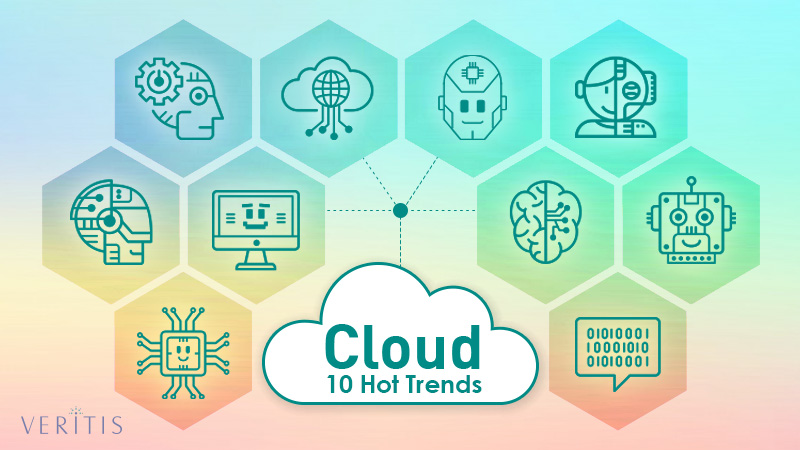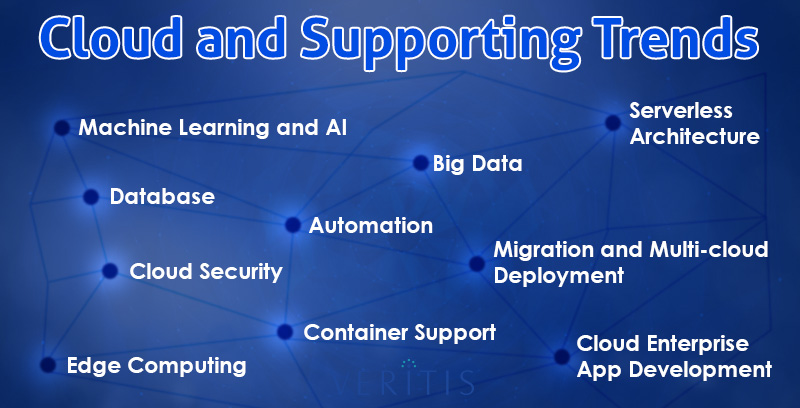
Given the skyrocketing demand for fast-paced service and application delivery, Cloud is no doubt a hot trend, globally.
Demand for advanced applications that can run high-end and even mission-critical operations created the scope for application development and their deployment over the network for fast-paced execution, the key aspect of Cloud.
Eventually, application development and services on-the-go over the network added to the cloud’s leading position in today’s IT industry.
Some of the most-hot cloud and supporting trends:
1) Machine Learning (ML) and Artificial intelligence (AI)
AI and ML are buzzwords is an old statement. Now, they are at the core of IT operations, globally, driving the race. Surveys predict at least a 50 percent rise in IT spending on AI and Machine Learning over the next three years period. This is moving many cloud vendors to make new developments or expand services that allow effective utilization of these technologies in existing applications. Currently, the leading cloud service providers AWS and Azure are already offering ML tools.
2) Big Data
Mining, managing and retrieving accurate and appropriate data from huge volumes of available data form the heart of Big Data functionality. Cloud platforms help companies make the best use out of a wide variety of tools for analyzing, processing and managing high-volume data sets without the time or capital investment needed for an on-premises deployment.
3) Serverless Architecture
Getting away with the critical task of server maintenance is one key relief that a serverless architecture typically offers. Serverless architecture helps developers build or run services without having to keep a watch on the underlying infrastructure, improving the scalability of services. Adopting a serverless architecture is no more a concern with the cloud as most of today’s cloud providers use standard technologies making it easier for moving serverless applications from one vendor to other.
4) Migration and Multi-cloud Deployment
Migrating to cloud platforms is one process that has already begun all across. But moving the existing environment to the cloud is not that easy and faster without skilled professionals, which can result in business risk downtime on key applications and security vulnerabilities. On the other side, multi-cloud deployment is also common among those firms willing to have multiple environments to choose from, depending on cost and performance.
5) Automation
Automation of processes is one key aspect that every firm is looking to adopt to achieve fast-paced product development and delivery. Automation finds its full potential in the cloud in the form of auto-scaling, infrastructure-as-a-code (IaaS) and automated monitoring and reporting. Adding to this is a rising inclination towards third-party services that allow automation across multiple platforms using a single toolset.
6) Database
Database plays a crucial in cloud computing, given the fact that cloud technology involves dealing with large volumes of data over the network. This would ultimately need hands-on experience in standard database languages such as SQL and MySQL along with advanced open-source technologies.
7) Cloud Security
Security is one of the top cloud-related competencies that firms are in the hunt for in 2018. While the cloud offers ease in execution over the network, security remains to be the key concern for many firms with regard to data safety on the cloud. Many firms report lack of confidence for full-fledged cloud adoption majorly because of security in line with compliance requirements. So, cloud security is one of the top expectations of IT professionals.
8) Container Support
A 2016 survey reports two-thirds of its respondents expressing readiness to explore the usage of containers if they weren’t previously. According to experts, containers feature among the must-have cloud skills majorly because of the server efficiencies that make them the best option for cloud providers. A containerized cloud environment performs 50 percent better than the regular Virtual Machine environment. The application container market is most likely to grow to a market size of USD 2 billion by 2020.
9) Cloud Enterprise App Development
A combination of DevOps and cloud-based enterprise application growth is considered as one of the key aspects to boost performance development. While DevOps fills Development and Operations gaps, fast-paced application development in cloud adds to the effectiveness of DevOps collaboration. Cloud-based enterprise application development is preferred over traditional methods of application development as the latter involves multiple networks and platforms under strict governance for effective results.
10) Edge Computing
Given the demand for smart wearable technology devices, Edge computing is also one of the top hot cloud-driven technology trends requiring more of on-the-go services that are an integral part of cloud computing.

Some of the top and standard cloud-based certifications on demand include:
- AWS Certified Solutions Architect
- Implementing Microsoft Azure Infrastructure Solutions
- AWS Certified SysOps Administrator
- Google Cloud Architect Certification
- Certificate on Cloud Security Knowledge
- Oracle Cloud Infrastructure Classic 2018 Associate
Some of the top Cloud Tools for Collaboration include:
- Gmail
- Office 365
- Cisco WebEx
- Skype
- GoToMeeting
Why Cloud?
Deployment of cloud-based skillset is now very important for any firm and IT industry as a whole.
As the reports say, lack of cloud expertise is resulting in huge revenue losses for many IT firms, nearly to the extent of more than USD 200 million.
Besides, many firms also report slow pace of operations, delay in execution speeds and interruption of services without a cloud in place.
‘Cloud and Distributed Computing’ held top position among LinkedIn’s top 10 ‘skills-in-demand’ in 2018, followed by Statistical Analysis and Data Mining, Middleware and Integration Software, Web Architecture and Development Framework and User Interface Design, among others.
Another survey shows that 70 percent of companies run at least one app on a cloud platform, and the percentage went up in 2018.
When it comes to operations, nearly 50 percent of companies are effortlessly working to power their IT processes with cloud capabilities and many are thinking of ways to secure cloud personnel, either by training the existing or hiring new ones.
At the mid of 2018, nearly 7 in 11 companies added cloud-based job roles to their portfolio and 80 percent are looking at expanding their teams of cloud professionals.
Overall, migration to the cloud is the most-happening trend irrespective of the size of the organization; in fact, Small Medium Enterprises (SMEs) are more inclined to the cloud trend, actively looking out for effective cloud professionals who can help them out.
So, it’s demand time. Brace up to gain a competitive edge in the cloud-driven world!